

| Newsletter 37 | October 2001 |

Going
For
Colour
In this issue:
Our Children's Vision of the Jacobites
Thrashing Mill Memories
The Mystery of the Bogle Brig
More Recollections of the 1980's
A True (?) Dunning Ghost Story
+ much more
The Mystery of the Bogle Brig
The Face
One day two years ago, one of our members, Mrs. Jackie Gray, looked out her back window and got a terrible fright.
There, glaring at her through the window, was a horrifying face.
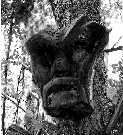 When she got over her initial shock, she looked more closely. It turned out to be nothing more than a wooden mask or head. Jackie and husband Bob's son Andrew had been walking up Dunning Den with some pals, had found the mask, and as a lark had put it in the family window.
When she got over her initial shock, she looked more closely. It turned out to be nothing more than a wooden mask or head. Jackie and husband Bob's son Andrew had been walking up Dunning Den with some pals, had found the mask, and as a lark had put it in the family window.
That evening, her heart still pounding, Jackie took the mask to Davie Doig, the man who has built and maintained the trail and bridge system of the Den. She knew he was a wood-turner by hobby: was this something which he had made?
"No, I've never seen it before," said Davie.
"Well, I really don't want to take it back home," said Jackie. "Would you mind please taking it and burning it or throwing it away?"
David agreed to take it. He had noted the face had its lower jaw missing. Just for the challenge of it, he decided to repair the mask.
But what to do with it then?
He'd enquired where the boys had found the mask, and it was near the furthest of the three footbridges he'd built over the burn in the Den in recent years. (The first one was the so-called Tory Brig, reputed in Dunning's informal history to have been a bypass for Conservative voters to avoid the Whig inhabitants of the village at election time).
Davie decided to return the mask to the same location it had been found. He nailed it up on a tree near the furthest bridge.
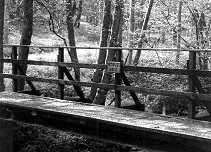 Because of its ugliness, Davie thought of it as a bogle, the Scots name for a terrifying ghost or phantom. On the railing he placed a small plaque, calling the bridge "The Bogle Brig". So be warned. When next you wander through the den, you may see a horrifying face up in a tree. Thanks to this article, you will have a perfectly rational explanation of how the mask came to be put there.
Because of its ugliness, Davie thought of it as a bogle, the Scots name for a terrifying ghost or phantom. On the railing he placed a small plaque, calling the bridge "The Bogle Brig". So be warned. When next you wander through the den, you may see a horrifying face up in a tree. Thanks to this article, you will have a perfectly rational explanation of how the mask came to be put there.
Of course one mystery does remain. Who made this ugly mask, for what purpose, and how did it come to be placed where the boys found it?
Perhaps it would be wise to be just a wee bit cautious as you walk over the Bogle Brig.
-Photographs by Alf Marshall, text by Lorne Wallace
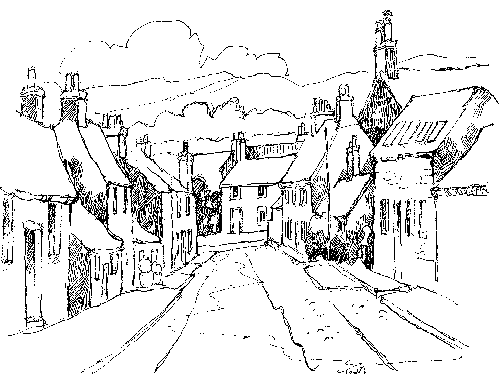
A pen and ink sketch of the Lower Granco by visiting artist
Tom Tinkler of Kelowna, B.C., Canada, Summer, 1999
A Delight in Monochrome...now
to add a Dash of Colour!
Please don't get us wrong. We love the charming illustrations so generously provided for our newsletters by local artists and occasionally by visitors (like the sketch above). We think these pictures are one of the principal reasons why people enjoy reading our Society newsletters.
That's why we hope to continue providing you in future with many more pen and pencil and charcoal drawings, pen and wash sketches, linocuts, black and white photographs (like those opposite) and other monochromatic illustrations.
But as you will have noticed already by the cover, we're now into colour. The dramatic picture of the Jacobite soldier was drawn by Rosie Aitken at just 6 years of age. She was one of the prizewinners in our 2001 Dunning Primary School history competition. (Other examples of the competition entries are included in this issue, and will also be on show at our November coffee morning).
Alf Marshall has designed a new colour adaptation of our familiar DPHS logo, as originally created by talented charter member Albie Sinclair, and that adaptation appears for the first time on the front cover of this edition of the magazine. We're also able to include in colour a centerfold picture from the history competition, and a back page in colour too.
So, moving cautiously, we now have the ability to produce a few of our magazine pages in colour. Not too many, probably only four pages an issue, because costs of reproducing colour are markedly higher than reproducing in black and white. (We say reproducing, not printing, because at present our newsletters are completed by a commercial photo-copy firm).
To help with this colour project, the Society has invested this year in a laser colour printer. This will not only enable us to print a few original pages of this and future newsletters in colour, but will serve as a backup to (and eventual replacement for) our now eight year old and well-used black and white laser printer. As well, we will be able to use it for printing posters, displays, handbills, stationery etc.
Please let us know what you think of our adding some pages in colour to your newsletters. We've already appreciated the comments on the latest newsletter changes from readers like Kate Brown in Dunning and Trevor Fulton in New Zealand, who find that the revised format makes for easier reading.
Do you think we're doing the right thing in going for colour?
|
THERE STILL REMAIN MANY TREASURES ONLY IN BLACK AND WHITE 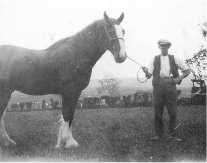
Take for example this old photo and the illustrations for the following article. They are pictures of unidentified local farm workers, collected by the late James Howie who worked at Rossie and other farms. Our thanks to his son Bill Howie and Bill's wife Zenka of Ochil Gardens for kindly letting us use these. |
Memories of a Farm Worker
by Cathy Dewar

Thrashing Mill Day
My first job at the grain harvest was when I was thirteen years of age.
I went to the stooking, taking the sheaves of grain which the binder (machine) had left lying on the field, and setting them into upright piles of several sheaves called a stook.
I didn't like it very much if it was a wet morning. When you turned the sheaves you got soaked.
When the stooks of grain were dry, the travelling Thrashing Mill came to the farm. There were almost always at least four women working on it plus the men. There was a millman who sat and fed the corn the right way into the drum. The sheaves were brought to him by two women. They hooked their wooden handled knife under the twine binding the sheaf, and handed it to the millman. Then they cut through the binder twine with their knives and the millman fed it evenly into the drum.
Two men worked on building stacks of straw. Soo stacks we called them. The straw shot out of the mill in bunches. Two women would trail a bunch in each hand, dragging it either to the outside stack or to the shed, wherever the men were building the stack. There one man forked it upwards to the second man who built the soo stack.
At first, when I started working on the mill itself, I was on what we called the Caff, or Chaff. This was the grain husks and broken straw which came out the back of the threshing machine and kept piling up on the ground. Nearby you laid out jute bags which had been split and sewn together to make a large sheet. You used a big wooden rake and raked the chaff onto the sheet. When it was full, you picked it up by the corners and carried it into the cattle courts. It was bedding for the cattle. (The same stuff was used for making the mattresses for the farm workers living in the bothies-they were called caff beds.)
I didn't much like working the Caff. It was dusty work. And you had to go into the Reed among the cows. It was all right if there was no bull. If there was you had to get out quickly.
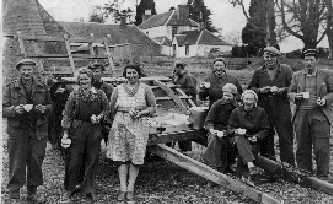
|
|
A thrashing crew at Baldinnes Farm. |
And then I started on the cutting of the sheaves on the top of the mill, and I enjoyed every minute of it.
When I started first we used to get our three course dinner but it all stopped after the War and then we started getting pies (meat pies from Robertson's Bakery) and that was not the same. However that's just one of those things, everything changes.
Here are some of the nearby farms I have worked on: Strathy Laigh of Rossie, Pairney, Rossie Bank, Rossie, Mosshead, Pitcairns, Boghall, Findony, Quilts, Knowes, Balgour, Dalreoch, Garvock, Bogtonlea, Leadketty, Wellhill, Clevage, Drum, Muirhead, and Keir (that's a farm that's disappeared now, buried under the dual carriageway).
That's just the ones I mind of, there were more.
Some of the farms had their own thrashing mills installed in the steadings, and thrashed stacks frequently to get just the amount of grain or straw they needed. I worked with the travelling mill which went from farm to farm at harvest time and winter and spring, to process all the crop at once.
Now there's no longer such a thing as a threshing mill.
The combine did away with a lot of work, and those days will never come back. We had some good times as well as some bad days, but generally it was happy days.
Tattie Time
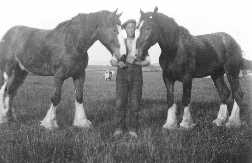
Another farm job I had was the tattie-dressing.
When I started at the potatoes at first there were no machines. We used what were called hoppers and screens and riddles. The work was all done with your hands.
After we dressed or cleaned the tatties on the riddles, we put them into the hoppers for putting into sacks.
It was outdoor work and each day we had to see and get our screens and riddles all cleaned and our hoppers prepared for next day.
The work dressing the tatties lasted for 6 weeks.
We went all over the place. We got Stevens at the garage. He had an old lorry to take us back and forward. We did go quite a good distance sometimes. It was great fun. You never knew where you were going.
Then the potato machines started and it did folk away from all the work.
After the Farm Work Ended
I then started at Hillside Hospital. I was there for 15 years. You had to retire when you were 60. That's where I finished and then I got wee jobs about Dunning here and there. But when you get to a certain age they won't take you.
I could go on forever. There was good times and bad times. It's life and you make of it what you can.
-Cathy Dewar, Bridge of Earn Road, Dunning, 2001
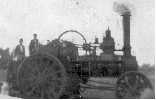
Many thanks to Cathy, who is one of the Society's founding members and a loyal supporter. She recalls it was Jimmy Howie who as millman first taught her how to handle sheaves. Our thanks too to Bill and Zenka Howie for providing the images of the anonymous farm workers in these photographs. |
Long Forgotten Memories
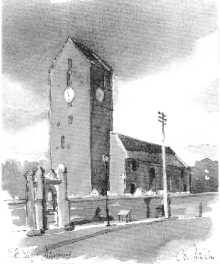
-from a watercolour
by Colin Davidson
of Aberfeldy
A short story by Ian Buick
Those who attended our Burns Night 2001 will remember Ian Buick for his marvellous recitations, including "Holy Willie's Prayer". Ian is a DPHS member living in Berwick on Tweed. The story below won second prize in a Borders writing competition, and Ian kindly e-mailed it to us for inclusion in our newsletter. Ian confides"All the events actually took place, but there's a wee bit of exaggeration".
The young boy's eyes shone with excitement. The time was mid summer 1952 and it was moving day. His parents had rented a new home in Dunning, a wee Perthshire village. He was five years old and for the first time in his short life he would have room to move and play.
Before this time he had shared cramped accommodation four floors up in a Dundee tenement with his parents and grandparents. Then he had moved to an equally cramped flat on the Perth Road of the village. The next move was different. There was a garden and even better there were outbuildings. What more could a young boy want?
At the back of the house were old stables with four stalls, a large garage designed to take the horse drawn vehicles of yesteryear and a loft. He had to be very careful in the loft because many of the floorboards were rotten. The house and grounds were explored as only a five-year-old can do. Scurrying up and down, he stuck his nose into every nook and cranny. It was utopia for him. Even though at that age he didn't know the meaning of the word. Not only were there hiding places everywhere, the outbuildings were filled with treasure. Well, junk really. Though to his active imagination it was treasure.
There were old pieces of harness in the stalls of the stables. There were pieces of metal in such weird and wonderful shapes that he could only guess as to what they had been used for. Perhaps pirates or outlaws had left them behind. In a strange high domed room, eight foot high and about three foot square, that had been dug into the slope of the garden, he found what was his most prized possession so far. It was the size and shape of a rapier that was triangular in section. He fought so many battles with that sword. His father said it looked like a pig sticker but the boy didn't know what that was, and wasn't worried about that anyway.
Life in the new home settled down. The boy walked to the Wee School, which wasn't too far from the house. He had his friends round to play almost every day. The house was a popular place to play for many of the local children as it had so many possibilities for different games because of its layout. There was always laughter and the sound of children. Life such as it was settled down into normality.
Then, the dreams started. They weren't too bad at first. Just a wee bit nightmare that couldn't be remembered in the morning. Gradually they got worse. Only snippets of them were remembered in the daylight. What could be remembered was the sudden sitting up in bed engulfed with the penetrating darkness and screaming. The fear paralysing his limbs. Perspiration trickling down his back making his pyjamas stick to him.
As time moved on, more and more of the nightmares could be remembered. They didn't come every night but at least monthly. Sometimes they even came weekly. Always they followed the same format. The boy in his dream went out into the yard of the house. It was daylight and he was the only person there. He reluctantly walked across the yard to a stable door. He opened it and entered the stable and looked round. Something was not right but he wasn't sure what. The stable was devoid of people or animals. Then the noise started. A cacophony of sound that was a mixture of screams. Not human screams, not really animal screams, but perhaps more animal than human. Then again, the screams were not like any animal sounds that he had heard before. Whatever was causing the noise, it frightened the boy.
He was rooted to the spot. About six feet into the stable he couldn't go forward yet he couldn't go back. Transfixed he was, within the maelstrom of sound. Then he looked down at his feet. Over the cobbled surface of stable bubbled the blood. Just a little at first, in little rivulets running in-between the cobbles. Gradually the volume of the blood increased. No longer running between the cobbles it poured in a spate over the cobbles so the floor was totally red. It spilled out of the stable door into the yard and all this was to an ever-increasing crescendo of screams as directed by the conductor of the nightmare. At this point, in every nightmare, the boy woke up.
This went on for three years. The boy became accustomed to this, as much as one can get accustomed to a nightmare. Not looking forward to it, but with an acceptance that had grown with familiarity. One day the postwoman came to the door with deliverance. The family had been allocated a soon to be built council house in Kirk Wynd. The family moved and the nightmares ceased.
Thirty years later, in 1984, the man, as he now was, picked up a holiday brochure for holiday homes to rent in Scotland. Flicking through it he wondered if there were any holiday homes to rent in his old village. Sure enough there were several different properties in the brochure. An icy shiver ran down his back when he read one of the entries, and long forgotten memories of nightmares came flooding back into his mind. "We have a new property on our books this year, Thorn Tree Villa. It is situated in the delightful Perthshire village of Dunning. This property has been extensively modernised but it still contains many of its original features. It used to be the old village slaughterhouse."
-Ian Buick, Berwick on Tweed
|
2002 Dunning Historic Wildlife Calendar | |
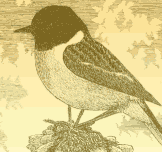
A beautiful |
Here's how to order the Society's |
Our Children's View of the Jacobites
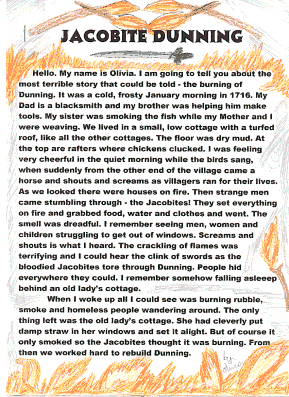
This year the Society began sponsoring an annual writing/ art competition for Dunning Primary pupils. The subject taken this year was the Jacobite razing of the village in 1716. Here follow a few of the many fine submissions. First that of Olivia Phillips, age 10, P6.
JACOBITE DUNNING
Hello. My name is Olivia. I am going to tell you about the most terrible story that could be told - the burning of Dunning. It was a cold, frosty January morning in 1716. My Dad is a blacksmith and my brother was helping him make tools. My sister was smoking the fish while my Mother and I were weaving. We Iived in a small, low cottage with a turfed roof, Iike all the other cottages. The floor was dry mud. At the top are rafters where chickens clucked. I was feeling very cheerful in the quiet morning while the birds sang, when suddenly from the other end of the village came a horse and shouts and screams as villagers ran for their lives. As we looked there were houses on fire. Then strange men
came stumbling through - the Jacobites! They set everything on fire and grabbed food, water and clothes and went. The smell was dreadful. I remember seeing men, women and children struggling to get out of windows. Screams and shouts is what I heard. The crackling of flames was
terrifying and I could hear the clink of swords as the bloodied Jacobites tore through Dunning. People hid everywhere they could. I remember somehow falling asleep behind an old lady's cottage.
When I woke up all I could see was burning rubble, smoke and homeless people wandering around. The only thing left was the old lady's cottage. She had cleverly put damp straw in her windows and set it alight. But of course It only smoked so the Jacobites thought it was burning. From then we worked hard to rebuild Dunning.
The Jacobites
In 1716 the English army and some Scots met at Sheriffmuir and had a battle with swords and other weapons. The Jacobites took their heavy belts and their long tartan material, that they used for kilts, off and started to fight but sadly the Jacobites lost. The Jacobites fled and burned Blackford and Auchterarder and stole their food and clothes. Then they came to Dunning and were going to ransack the village, but one old lady wouldn't let them get her food and clothes. She got some damp straw and set it alight so it just smoked and when the Jacobites came they thought they had already got food and clothes out of that house. They went all the way to Perth to destroy it. When the Jacobites had gone the old lady took the damp straw out of her house. The house was the only one left standing in Dunning. All the other people were homeless to they went to the local farms and houses to get food and clothes. Then they started to rebuild Dunning.
by Roslyn Andrews

Ye Jacobites
(The First Rebellion)
Ye Jacobites I say
They burned Dunning one day
It was a long time ago
In the year 1716
Jacobites so keen
To burn down Dunning
But those whom thought
That they could not
They were o so right.
The one house that lived
Still there today
In the past made of straw and hay
Now in modern day made of brick and blocks
Yes ye Jacobites I say
Burned Dunning one day.
--Shelley Dewar
Jacobites Burn Dunning
Hi, my name is Jamie. I am an eleven year old boy, who used to live in the village of Dunning.
One morning, in January 1716, I had to get up early to help my dad fix the leak in the roof, because when it rained, the house floor got very slippery and soggy. I started by climbing up on to the roof, grabbing the chimney to help pull myself up. Then suddenly, I stopped, and thought to myself about all the horrible smells and how we lived, it just didn't make sense. "Jamie, Jamie!" said my dad loudly and angrily, finishing his sentence with "snap out of it, we don't have all day!"
My dad passed me up a big rock, some straw, and a long piece of rope. I got busy, filling up the hole in the roof. I later jumped off the roof onto the hard grass. Oh No! I had a grass stain on my new white shirt. My mum was going to kill me!
I walked inside the house very slowly, with a big innocent look on my face and went towards my mum, who was sweeping the floor. I gently tapped her on the shoulder and pointed to the grass stain on my shirt. WHACK!, she gave me the hardest smack she could, right across my lug. She hurriedly pulled the white shirt off my back, and then tried to clean the grass stain off, but it didn't work. She then totally flipped and began to shout at the top of her voice. I couldn't stand it anymore, so I ran outside, and kept running to the top of the hill, suddenly realising I didn't have any clothes on my back. I sat down on a big rock, puffing and panting, when I heard a loud noise coming from over the hill. It sounded like a hundred men, screaming, and running towards the village. I ran as fast as I could back to the village shouting "the Jacobites are coming!"
I rushed into the house, up to my dad, and told him about the Jacobites coming over the hills. Of course, he didn't believe me, until he heard it for himself. He stood at the door with my mum, looking around and not seeing anyone. Then they heard people shouting and screaming. Suddenly two men appeared at our door and pushed us out of the way.
One of the men took my grass-stained shirt, one of my mum's old rags and two pairs of my dad's shoes, as well as most of our food and drink. The other man pulled out his musket and took a shot at a pile of dry straw. It caught fire. Quickly! yelled my mum, let's get out of here. The two men ran away with all our stuff. My mum and dad grabbed what was left of our clothes. Outside, it was even worse. There were crowds of men, still burning down the village houses. We went down the hill to see how Miss Darwin was, because she was 53 years old. When we arrived, the house was smoking and flames were appearing. My dad went inside to look for her. She was coughing badly, with the smoke inhalation, but he carried her out to safety.
About twenty minutes later, all the Jacobites were gone, at last! You could tell by the look on people's faces, that they were absolutely devastated! Further down the road, was another old lady called Mrs. Wood. Her house was not damaged at all, but it was smoking. She proceeded to tell us how she set the wet straw alight, to make it look like her house was on fire.
The whole village was still in flames, but it was time to build a shelter for the night, for tomorrow we start to build a new home...
--Jamie Bussey
|
Death of John R. Crow On July 13, 2001, John R. Crow died suddenly of a heart attack in his garden at Pansy Cottage, Thimble Row. John was 66 and had been retired for just a year from his work as a builder. One of his passions was collecting postcards of Dunning, and loans from his collection had been an important source for the book 'Dunning, A Village of Crossroads and Characters', which the Society has just reprinted. John's collection of postcards and photographs was the theme of our 1994 coffee morning, and John also contributed to the memorable 1997 Society-made video, Tradesman's Tales. |
Another Crack at the Quiz
The second annual Auchterarder Festival staged another Team Quiz Night in July, and again Dunning Parish Historical Society entered a team. (Last year's team had finished in runner-up spot). We can report that our team of Marilyn and Archie Jamieson, David Wilson, Jeanette Peebles, Fiona Kinross and John Stockley Jr. did well against the 37 other teams, finishing just out of the top four. We note the winning team from the Auchterarder Tourist Board had four Dunningites on board: Janet Crowe and daughters Catherine and Louise, and Lena Stewart.
The Clock-Minders
When St. Serf's Steeple clock was set a-going again in 1994, with funds raised locally by Dunning Community Council, the Council set up a rota of local residents to keep the clock wound and corrected weekly. The volunteers so far have been men, because winding the clock is physically demanding. The current clock team includes Bill Anderson, David Pentland, Simon Warren and David Hamilton. The work is also a bit risky because the worn and narrow staircase in the steeple is unlit. Now that Historic Scotland is putting in lighting for the Dupplin Cross display, it may be a chance to provide some stair lighting for the doughty clock-minders.

This newsletter is published quarterly, January, April, July and October by the Dunning Parish Historical Society. |
Proxime Accessit (part two)
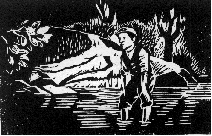
-linocut by Albie Sinclair
In our last issue, James Dixon began his unusual recollections of his formative years growing up in Dunning, way way back in the nineteen-eighties. James is now a lawyer in Sheffield (not Leeds as we incorrectly said). He ended by recalling how he received the award of proxime accessit, runner up to the dux, at the Dunning Primary School at the important annual school prizegiving.
Another big event in Dunning was the sports day involving various challenges including the 'egg and spoon race' and the 'tattie sack race'. This was a fine afternoon for the families of the village.
I was also a member of the cubs and scouts when they met in the old wooden hut down Kirk Wynd. I have some fond memories of them including a trip to Broxburn in Edinburgh with the Cubs when a lady from Bridge of Earn was leader. I remember too the Scouts led by Scott Smith and Ronald McLeish. We used to play a tough game with a medicine ball (a really heavy ball with stitching), the object being to hit everybody with it until there was only one left standing, who was the winner.
One year we had a camp along the Bridge of Earn Road when we had to make fires out of nothing. I got bored on the Saturday afternoon and decided to desert the camp to spend the afternoon in bed at home watching Grandstand. I was terrified that Mr. Murray (another Mr. Murray, Allan Murray), the senior scout leader who lived up the Dragon, would see me running back to Dunning along Bridge of Earn road.
In the summer holidays there was a project for the Cubs and Scouts called 'bob a job'. This involved walking around the village and cycling around the outlying areas, knocking on doors and asking the residents if they had any jobs that needed to be done. The typical things were weeding the garden, cleaning windows and washing the car. The resident had to sign a sheet and record what we had done. In return we earned some money which went to charity. It was a great thing and we really felt proud to do it. It also enabled us to meet people in the village who we otherwise did not see very much. I remember doing Mr. Bain's weeding who lived at Hollycroft up the Dragon.
Sometimes it snowed in winter and the snow lay for a week or two. I really got excited when this happened and I often spent the whole day outside, sledging and building toboggan runs on the
 Dunnock with people like Grant Robertson and Morgan Sinclair. I recall that one winter the snow stayed for longer than usual. I think it was the winter of '85-'86. After a while people started to ski on the Dunnock hill. Usually they skied on the Old Golf course but this particular year the snow was so abundant that they were able to come down the Dunnock. It was the perfect place for me as my gran lived right at the bottom of the 'piste'. After a while Dunning Ski Club was formed and a man called John who lived opposite Thimble Row and who was a very proficient skier made an improvised ski tow. He parked his little van at the bottom of the hill, took a wheel off, attached a rope around that hub and connected the rope to a large bicycle wheel and pulley which was fixed to the telegraph pole near the entrance to the wood at the top of the hill. This formed a long tow. I remember that Hector and Ross Whytock were involved as were Raymond Cairns and John Smith.
Dunnock with people like Grant Robertson and Morgan Sinclair. I recall that one winter the snow stayed for longer than usual. I think it was the winter of '85-'86. After a while people started to ski on the Dunnock hill. Usually they skied on the Old Golf course but this particular year the snow was so abundant that they were able to come down the Dunnock. It was the perfect place for me as my gran lived right at the bottom of the 'piste'. After a while Dunning Ski Club was formed and a man called John who lived opposite Thimble Row and who was a very proficient skier made an improvised ski tow. He parked his little van at the bottom of the hill, took a wheel off, attached a rope around that hub and connected the rope to a large bicycle wheel and pulley which was fixed to the telegraph pole near the entrance to the wood at the top of the hill. This formed a long tow. I remember that Hector and Ross Whytock were involved as were Raymond Cairns and John Smith.
I also recollect that Alan Crow, in his red suit, had the most fearsome reputation as he took the most direct and steepest route down the hill which was nearest to the fence. The snow eventually became packed and hard just like a proper slope. We had hours of fun on the Dunnock that winter. I even became a competent skier.
I have less proud memories of the junior football club. There had been no club for a number of years and then Johnny Allen decided to start an under-14 team. I was the goalkeeper and it is to my shame that I have to say that we often lost with score lines like 10-0 and 8-0 against sides such as Perth Rovers and Blairgowrie.
The fortunes of the club improved when Alex took over. He was the brother of Annie Lafferty and he drafted in some talent from outside the village to the resentment of some villagers who preferred to be drubbed every week for the sake of the preservation of village purity. Under the guidance of Alex we actually started to win and draw some matches. I remember that we once had a dance in the village hall to raise some money for the club. It was a roaring success though I was disappointed when the player of the year award went to George Murray and not to me.
As I grew up I filled my time with golf and tennis, especially golf. Sometimes I spent the whole day on the golf course, playing about 81 holes. I have even been known to play at night with a yellow ball. There was no such thing as a fair weather golfer. The junior club was very well run by Dunc McAlpine who gave of his time and energy to encourage us youngsters. Sometimes we had team matches against clubs like Muthill whose golf course seemed to be squeezed onto a postage stamp.
Another feature of village life was of course Hogmanay. I was too young to really experience this but I recall that people would still be wandering about the village hoping to first foot somebody two or three days afterwards.
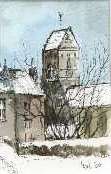 - drawing by |
When I got a little older, about 12 or 13, I used to go down to the square to see the new year in. It was great when everybody started to dance and celebrate. It was a magical time as the animosities and antipathies of the villagers seemed to be suspended in a wave of goodwill and forgiveness resonating in the old song "Should auld acquaintance be forgot and never brought to mind". There were sights to be seen in the square when it struck midnight. One year a friend of my father's from Sheffield, Terry Keating, quite a large man in more ways than one, was dancing in the most dainty fashion possible and spinning in a manner that a champion ice dancer would have been proud of. I remember that Betty Black was in the same group linking arms with Terry.
There were particular houses which were well known for their atmosphere and welcome and where greater numbers were always sure to gather. One such was Lyn and Brian Murray's down the Kirk Wynd where good lentil soup was to be had, just the thing to absorb some nips. I remember calling there after we left the village when my parents still felt the pull of a Dunning Hogmanay. This had particular significance for me as I was fond of their daughter Lee.
I also remember Dunning Gala Day very well. This was a great event. There was a variety of stalls with such things as 'guess the weight of the cake'. There was a tug of war between the three pubs together with a whole range of other challenges like throwing the welly, throwing the weight behind oneself over a bar and the coconut shy, to mention a few. There was also a fancy dress parade and the election of a girl as 'Miss Dunning'.
--James Dixon, Sheffield
Our Keelies Make it Into Texas History
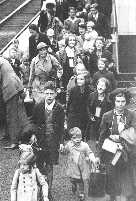
Anna Zirondelli, my granddaughter, is thirteen years of age and is a 2nd year student at Opal Hamilton Junior High School, Cypress, Texas. Cypress is north and west of Houston. Texas History is one of the subjects in her school's curriculum and as a project she had to interview a person who had lived through World War II and then write up the interview.
What follows is the outcome, which I thought might be of interest for your quarterly magazine as she used "Here Come The Glasgow Keelies!" as an additional source of reference.
--Thomas Lloyd Inglis, Fintry, Stirlingshire
World War II Interview
By Anna Zirondelli, Cypress, Texas, May/2001
I interviewed my grandfather on my mother's side, Thomas Lloyd Inglis. My grandfather was born in Glasgow, Scotland on March 01, 1934. He is 67 years old and lives with my grandmother Elsie Morag Inglis in a small village called Fintry, in West Stirlingshire, 20 miles to the north of Glasgow. He has lived in Scotland all his life and my mother, Heather Zirondelli, was the first of their family to go and live abroad.
World War II, 1939-1945, greatly affected the lives of the Scottish people along with those of many other nations. My grandfather was 5 years old when the war started and was living in Glasgow with his father, mother and sister Marion, my great aunt. Their father, my great grandfather George, born on December 21, 1899, worked for the railway as a coachbuilder and because his job was vital to the war effort it was called reserved employment. This meant that people having such jobs were not called up to fight in the war but were more needed at home. Other such jobs were farmers, engineers, government officials etc.
Glasgow, and in particular Clydebank, was an important ship building town and as such an important target for the enemy (Germans). Glasgow was heavily bombed during the war and because of this my grandfather was sent, along with his mother and sister, to the countryside to live. These are the places he lived in during the war:
| September 1939- March 1940 | - Whitecross, West Lothian | |
| March 1940- July 1940 | - Glasgow | |
| July 1940- January 1941 | - Lamlash, Island of Arran | |
| January 1941- August 1941 | - Glasgow | |
| August 1941- August 1943 | - Dunning, Perthshire | |
| March 1943 | - Glasgow |
My grandfather remembers how difficult it was for them to leave their father in the city because every time they heard reports on the radio of the bombings they did not know if he was safe. This evacuation of women and children to the country side happened all over the country and for these city people it was the first time some of them had ever been to the country or ever seen a cow or hen or any other farmyard animal except in books. The evacuees actually had a better way of life in the country because they had fresh food to eat and clean air. The country folks called the evacuees "Glasgow keelies".
My grandfather sent me a book Here Come The Glasgow Keelies published by the Dunning Parish Historical Society. In it I found the meaning of keelies, "a pejorative term meaning rough young working class people from the city" and on the back cover a photograph of him and my great aunt Marion when they were small children.
Evacuation also put a financial strain on each family because they now had to pay for the upkeep of two homes, but to guarantee the family's safety the price was cheap.
One of the tactics used by the Scots to trick the German bombers was to light fires in the hills around the city so that the night bombers would think that was where the city was and they would drop their bombs in the hills instead of in the city. Everyone had to use blackout curtains on their windows so that at night the lights from inside the houses would not be seen from above.
My grandfather was a small boy during the war but he remembers how his parents worried about what was happening in Germany and how there could be a possible invasion of the United Kingdom. The bombing of Pearl Harbor was not of such great concern because the threat from Germany was much closer to home. During the fall of Singapore there were a lot of British lives lost. The United States was not in the war at that time so the fact that the United States was going to be involved because of what happened at Pearl Harbor was seen as a good thing.
The bombing of Japan using the atomic bombs seemed, at the time, to be the culmination of the war and that there really was no other choice. The Japanese were treating the prisoners of war horrendously. Because they had surrendered, the Japanese looked upon them as traitors and treated them accordingly. The Japanese used the prisoners of war to build the Burma railway and thousands of them died doing it.
My grandfather says that in hindsight war is certainly not a solution to a problem because the dire consequences far outweigh the gains. As a result of his experiences during the war in the Dunning countryside he decided to study agriculture at college and has kept a close connection with the countryside where he spent most of the war. -Anna Zirondelli, Texas
In our next issue, Grandfather Lloyd tells us in his own words how being an evacuee in Dunning shaped his life
A Faraway Member Suggests a Nearby Destination
-a letter from Don Hepburn, Toronto, Ontario
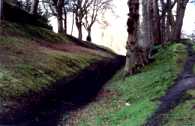 Along Antonine's Wall |
I have read the accounts of Dunning during Roman times. At another period in their conquest, the Romans built Antonine's Wall, an earthen structure, roughly on a line from Boness to Glasgow, in an attempt to contain the savages from the north.
As part of my trip this year, I visited the site of the Millennium Wheel Project. The location of the site is interesting. It is close to the remains of a Roman fort at Rough Castle and the best piece of Antonine's wall to be seen, located at Watling's Lodge, just down the road.
The Millennium project involves rejoining two 18th century canals. The Union Canal carried traffic from a point in Edinburgh (near the King's theatre) to Camelon. There through a series
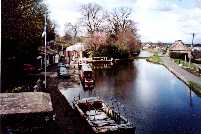 The present Union Canal |
of locks, the canal descended to the Forth & Clyde Canal. The Forth & Clyde Canal connects Grangemouth on the Forth to Bowling on the Clyde. In that way heavy commercial goods were transported between Edinburgh and Glasgow by horse drawn barges.
In time this traffic was completely replaced by the railway, and the Union Canal became unused. During the 1930s, the locks which joined the two canals at Camelon were filled, and eventually the land was covered by a housing development. The Forth & Clyde Canal remained in service until the fifties and saw much use during World War II shuttling boats, such as MTBs and Air/Sea rescue launches, between the coasts.
To rejoin the two canals now involves extending the Union Canal, which unfortunately brings the junction point in conflict with the Roman Wall! So, through a series of locks and a huge excavation, it is brought to a point lower than the base of the Roman Wall. The canal then goes
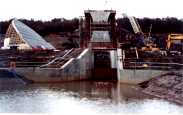 Site of Millennium Wheel |
through a tunnel under the Edinburgh/Glasgow railway track and the Roman Wall. Boats are to be picked up at the other end of the tunnel by the Millenium Wheel and placed in a channel which connects to the Forth & Clyde Canal. There is an amphitheatre under construction for spectators viewing the Millennium Wheel when it is in operation some time in 2002.
Falkirk is only thirty miles from Dunning. This might be a place which some DPHS members would like to visit. It would provide interest for Roman History and the Millennium Wheel, a two for one deal in one trip!
--Letter and photos from DPHS member Don Hepburn, Toronto , Ontario
Society Happenings
A Trip to the Trains, July 1. About 30 of us enjoyed super weather in Almondbank where Dunning resident Drummond Mailer had arranged for us to visit the Perthshire Steam model railway track. The degree of detail on these locomotives accurately replicating the full size is fascinating. We had rides around the track. The sight, sound and smell of the coal, steam and hot oil brought back memories for most of us. -Simon Warren
Know Your Village, August 2. The rain held off, and close to 80 people were entertainingly informed and guided around Dunning by natives Jim Smith, Elspeth Pentland, Ian Philip and Mary Arthur, each with personal anecdotes and memories. The much-enjoyed evening climaxed in a visit to the Society office in the Old Schoolhouse and a barbecue.
A Tale of Three Towers, Sept 5. Lindsay Lennie of Muthill held the audience spellbound at our first indoor meeting of the season, with a slide look at architectural features comparing Dunning , Muthill and Dunblane. Our thanks to Mrs. Lennie for a fine start to our new season!
|
WE APPRECIATE YOUR CONTINUED SUPPORT. |
|
|
The DPHS 2001-2 |
|
Thursday, October 11, 7:30 pm Village Hall. "A Wildlife Evening" with a combination of members' wildlife footage, a video on old local steam trains, and an intro to our wildlife calendar.
Saturday, November 3, 10 am Village Hall. Our Coffee Morning on the theme "Just Bring a Smile". As well as a display of pupils' art, we're going to demonstrate our latest Society camera, video and computer equipment, using guests at the coffee morning as the subjects. So come and "Just Bring a Smile".
Thursday, December 6/01, 7:30 pm Village Hall. "The Weavers of Dunning and Strathearn". Colin Mayell of Crieff is writing a book about the handloom weavers of this area. Their home-based industry shaped our buildings and our village.
Thursday, January 17/02. 7 pm "Burns Night" Another evening of food and entertainment. Book early at Dunning Post Office.
Thursday, Feb. 14/02 7:30 pm "Members Night" Raymond and Jean Young tell of their Japanese tour: Hiroshima and Nagasaki.

Further details about events in our January newsletter. Make sure you don't forget |
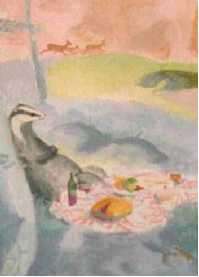
Do You Know Where This Image
By A Dunning Artist Can Be Seen?
In our next issue:
Paintings to calm and soothe
Dogs: why man's best friend?
The return of the lost soldier
and other informative features
DON'T MISS ANY ISSUES.
SEND IN YOUR SUB NOW!